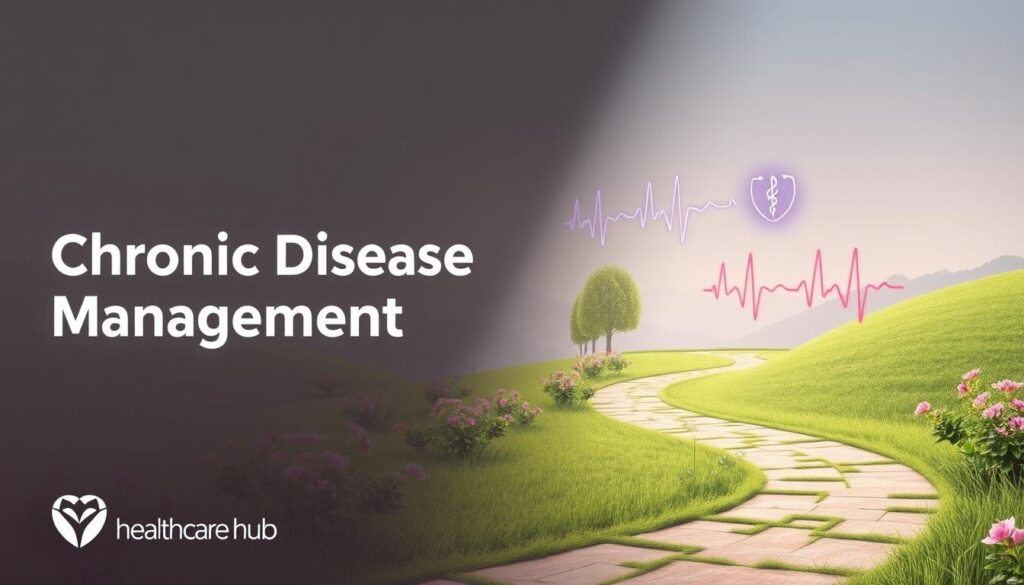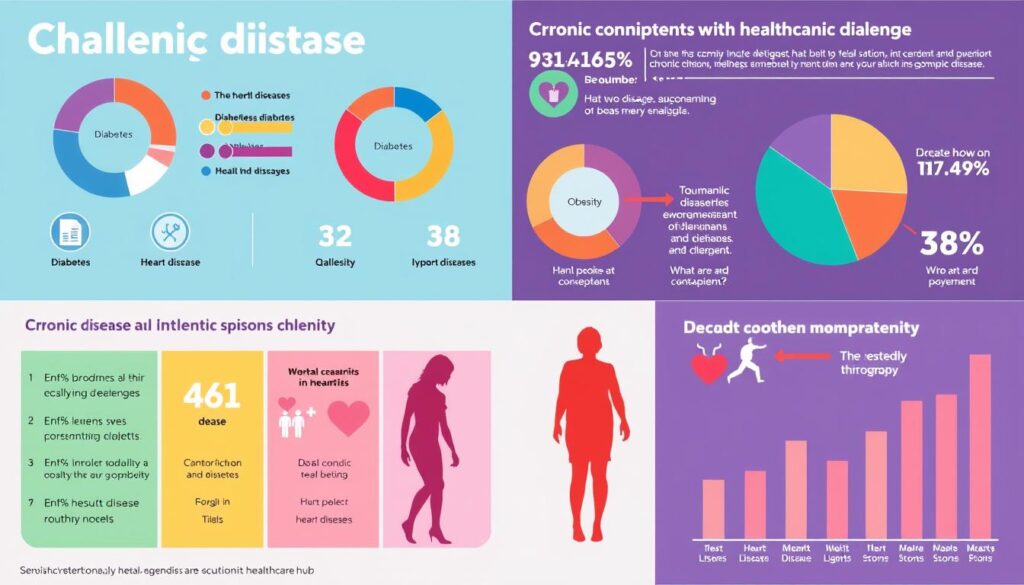Chronic Disease Management (CDM) is a special healthcare service for people with ongoing health issues like diabetes, high blood pressure, and heart disease. It aims to make life better for patients, boost their health, and help them get the right treatments. Almost half of Americans have at least one chronic disease, making CDM key to their health journey.
At the heart of CDM is ongoing care, education, lifestyle advice, managing medicines, and custom treatments. Doctors and patients work together to create care plans that fit each person’s needs. This way, CDM helps patients manage their health and improve their future health outlook.
Key Takeaways
- Chronic Disease Management (CDM) is a specialized healthcare service that supports individuals with persistent conditions like diabetes, hypertension, and heart disease.
- The primary goal of CDM is to improve the quality of life for patients by enhancing overall well-being and ensuring effective treatments.
- CDM involves a comprehensive approach that includes continuous monitoring, education, lifestyle guidance, medication management, and personalized therapies.
- Nearly half of Americans have one or more chronic diseases, making CDM a crucial element in their journey towards better health outcomes.
- By empowering patients to actively participate in their own care, CDM enables individuals to take control of their health and improve their long-term prognosis.
Understanding Chronic Disease Management and Its Impact
Chronic Disease Management (CDM) is a detailed way to handle long-term health issues. It includes regular checks, patient education, and following evidence-based guidelines. This method helps people feel better, live better, and coordinate care with doctors.
Defining Comprehensive Care Approach
CDM is more than just treating symptoms. It’s a detailed plan that includes:
- Checking the person’s health history and current status
- Teaching patient education to understand the condition better
- Managing medicines to make sure they are taken right
- Regular visits to check on progress and make changes
- Helping with lifestyle changes like diet and exercise
- Working together with different doctors for better care coordination
Role of Patient Education and Support
Teaching patients is key in managing chronic diseases. Patient education helps them know their condition, spot early signs, and help manage their care. This leads to better self-care and health results.
Goals of Long-term Health Management
The main goals of chronic disease management are:
- Improving the life quality of those with chronic conditions
- Keeping them healthy for a long time and avoiding worse problems
- Using evidence-based guidelines and treatments that fit each person’s needs
- Helping patients manage their health better, leading to better self-care

“Chronic disease management is not just about treating the condition, but about empowering individuals to take charge of their health and lead fulfilling lives.”
Common Chronic Conditions and Their Challenges
Chronic diseases like diabetes, hypertension, and COPD pose big challenges in healthcare. It’s key to know these conditions well for long-term care and better patient results.
Managing diabetes means keeping blood sugar levels in check to avoid serious issues. Hypertension needs constant watch and lifestyle changes to keep blood pressure healthy. COPD affects breathing and needs special care. Congestive heart failure requires specific heart treatments, and endocrine disorders need careful hormone balance.
It’s vital to tackle these chronic conditions well. They cause over 70% of deaths in the U.S. and 93% of Medicare costs. Using evidence-based guidelines and a team approach is crucial for managing these diseases and boosting patient health.
| Chronic Condition | Key Challenges | Prevalence |
|---|---|---|
| Diabetes | Blood sugar management, risk of complications | Nearly 1 in 10 adults in the U.S. |
| Hypertension | Constant monitoring, lifestyle changes | Nearly 1 in 2 adults in the U.S. |
| COPD | Breathing difficulties, specialized respiratory care | Affects over 16 million Americans |
| Congestive Heart Failure | Specialized cardiac treatment, high hospitalization rates | Affects over 6 million Americans |
| Endocrine Disorders | Hormone management, metabolic regulation | Affects millions of Americans |
Managing chronic diseases well needs a detailed, evidence-based plan. Knowing each condition’s specific needs helps healthcare teams create tailored care plans. This approach improves patient outcomes and quality of life.

Essential Components of Disease Prevention and Control
Managing chronic diseases well needs a mix of strategies. Three key parts are Medication Adherence Strategies, Lifestyle Modifications for Better Health, and Remote Monitoring and Self-Management Tools.
Medication Adherence Strategies
Sticking to medication is key in fighting chronic diseases. Patients can use pill boxes, apps, or alarms to remember their meds. It’s also good to check with doctors about medications and report any side effects.
Lifestyle Modifications for Better Health
Living a healthy lifestyle is vital for managing chronic conditions. Eating well, staying active, getting enough sleep, and avoiding harmful substances are important. These changes help control symptoms and lower disease risk.
Remote Monitoring and Self-Management Tools
Remote tools help patients manage their health better. Wearable trackers, digital scales, and blood pressure monitors let people check their health. Keeping a journal of feelings and side effects helps in managing care.
By using these tools, patients can work with their healthcare team. This partnership leads to better health and a better life.
Building a Multidisciplinary Care Team
Managing chronic diseases well needs a team effort. This team includes doctors, nurses, dietitians, and mental health experts. Working together, they help patients get better and live better lives.
Research shows that teams with different skills work best. For example, nurses with extra training can help patients a lot. Doctors who usually just consult can also make a big difference.
Good teamwork is key. Teams meet often to share information. This way, everyone knows what the patient needs. This Multidisciplinary Approach to Care Coordination helps patients manage their health better.
“Participation of medical specialists in consultative and educational roles can contribute to better patient outcomes.”
Creating a team takes work, like solving trust and communication issues. But the benefits are huge. It’s a must for managing chronic diseases well.
Empowering Patients Through Self-Management Support
Self-management support is key in helping patients with chronic conditions. It gives them the knowledge and confidence to manage their health. This means understanding their condition, making smart treatment choices, and adopting healthy habits.
Patients are encouraged to speak up and take an active role in their care. This includes advocating for themselves and noticing when something’s off.
Mental health support, like mindfulness and support groups, is also crucial. Studies show it boosts patients’ mental state and relationships. It also helps reduce healthcare costs.
The focus is shifting from treating diseases to empowering patients. This change highlights the importance of patient empowerment in managing chronic conditions.
Digital health tools and reliable information are vital for patient empowerment. By combining public health and knowledge management, healthcare can better empower patients. This leads to better chronic disease management outcomes.















Hairstyles
Hi, Neat post. There’s a problem with your website in internet explorer, would check this?IE still is the market leader and a huge portion of people will miss your magnificent writing due to this problem.